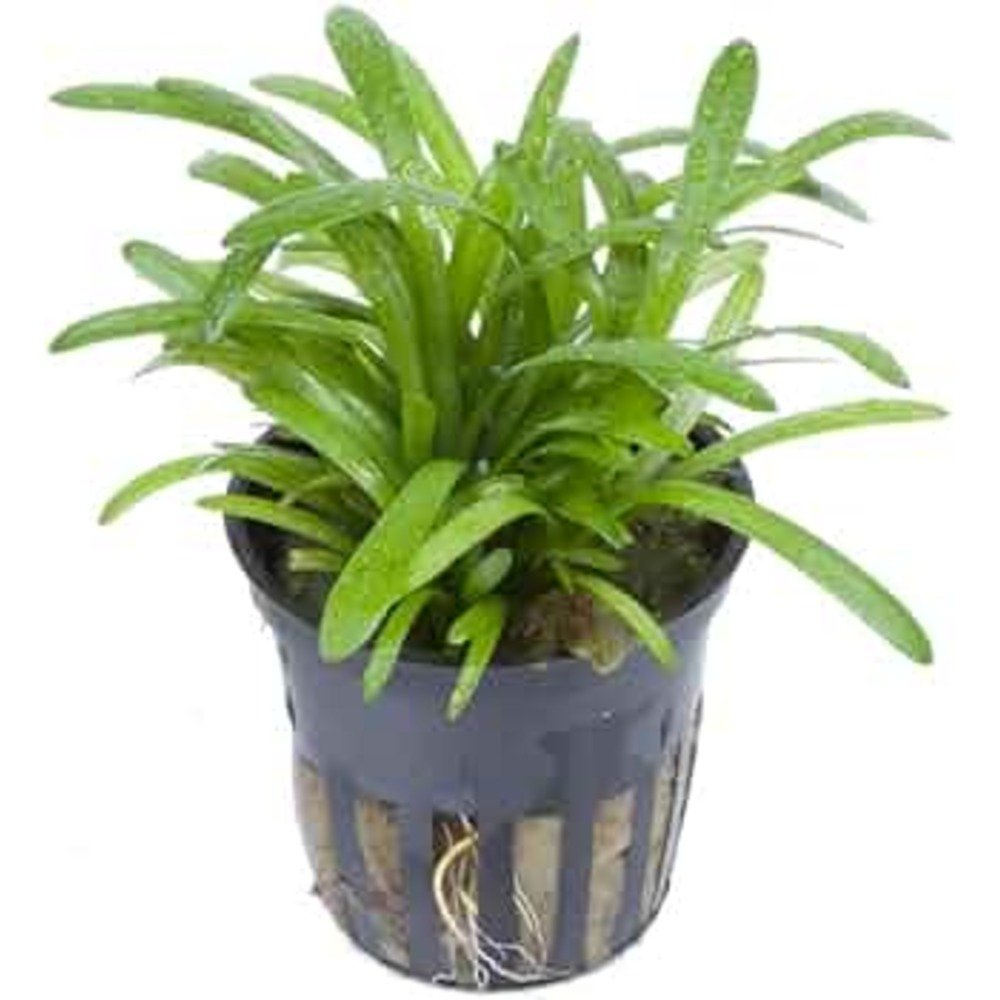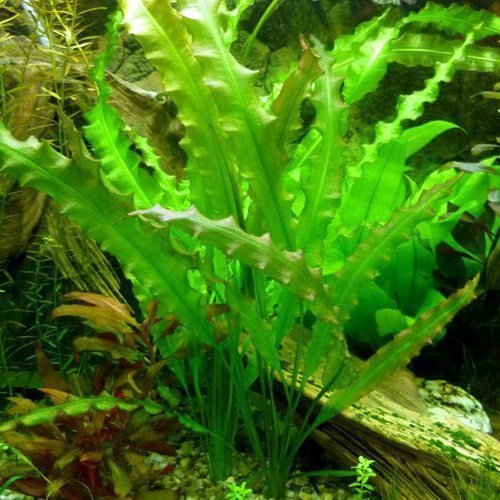-
Sagittaria subulata from South America is an ideal, undemanding foreground plant whose short runners form a compact group. Place individual plants 2-4 cm apart. This plant may cause problems because in certain conditions it suddenly grows to a height of 50 cm when it grows older.
-
Limnophila sessiliflora is a hardy, adaptable and undemanding plant from South-East Asia and is naturally found in slow moving blackwater and clearwater habitats with soft, acid water and low nutrient content. This plant is sometimes called Asian Marshweed or Ambulia. L. sessiliflora is capable of withstanding a wide range of water conditions (pH 5.5-8 and temperature range of 22-28C). Lower lighting and CO2 addition is recommended as this produces more compact growth. However, this plant does not require CO2 addition and will grow at a steady pace even without CO2. This plant does require good amounts of traces, especially iron supplementation, to stay in good health. Higher lighting and ample micronutrient supplementation cause this plant to develop reddish hues on the top. In good growing conditions it sends out runners and spreads across the bottom. A nutrient rich substrate is not necessary when growing this plant, as it is able to derive all needed nutrients from the water column.
-
Vallisneria gigantea (common name: eelgrass, tapegrass, vallis) Overview: Vallisneria gigantea is native to the tropical and subtropical regions of Asia, Africa, Europe and North America. This perennial plant thrives well in wetlands like ponds, lakes and quiet streams as well as slow moving rivers and streams. True to it’s name, Vallisneria gigantea grows tall with leaves growing up to 1 m long. They are suitable for larger aquariums with bigger fishes in it. It is fast growing (almost 1 cm a day), therefore pruning is highly recommended if used in aquariums. It is fairly undemanding, and thrives well when an iron-rich fertilizer is added to water. Appearance: The leaves of Vallisneria gigantea grow in clusters from the root and float above the surface of water. The leaves are long and can grow up to 48 inches long and 0.4 inch wide. The leaves are dark green in color with rounded tips and prominent raised veins. They are tough and not eaten by herbivorous fish. The white flowers have three petals and arranged in tubular form towards the end of the peduncle on water surface. Hard / soft plant: Hard plant Ideal water temperature: Vallisneria gigantea grows well under optimum temperature range between 20 and 28 degree Celsius. Lighting conditions: Vallisneria gigantea prefers high lighting intensity but grows well under moderate lighting conditions as well. Ideal pH conditions: Vallisneria gigantea is not fussy about water hardness or pH levels, but it has been found to grow fastest in alkaline water. Functions and advantages: 1) When planted in groups Vallisneria gigantea provides habitat for fishes and birds. 2) It’s large leaves are ideal for concealing filters and pipes in aquariums and increase the aesthetic appeal of fish tanks. 3) In larger water bodies, it controls free-floating algae growth on water surface. 4) It is compatible in fish tanks with gold fish in them as the tough and strong leaves of Vallisneria gigantea are not edible for these fishes. Did you know? Vallisneria gigantea is found in large patches on the surface of permanent water bodies. It reproduces via water pollination. The male flowers are released under water and upon reaching the water surface they are encapsulated by the female flowers and reproduction takes place.
-
Cabomba caroliniana (Common name: Fanwort, Carolina fanwort) Overview: Cabomba caroliniana originated from Brazil, and now is found all over the North and South America. It is a rhizomatous, perennial aquatic plant with stems that can grow up to 2 meters in height. Cabomba caroliniana is found growing in ponds and lakes, as well as in slow-moving streams and rivers. Appearance: Cabomba caroliniana has two kinds of leaves; the submersed and floating leaves. The former leaves are petioled, opposite whorled and about 2 to 5 cm wide. The smaller floating leaves are linear-elliptic in shape and are only 6 to 20 mm wide. It bears white flowers with yellow, pink or violet centers. Hard / soft plant: Hard plant Ideal water temperature: Cabomba caroliniana prefers a warm humid climate, but has also shown living characteristics under frozen water surface. Lighting conditions: Cabomba caroliniana prefers high lighting levels, at least 3 watt per gallon. Full spectrum T5 or T3 fluorescent bulbs are ideal for it’s growth. Ideal pH conditions: Cabomba caroliniana can tolerate hard and soft water, but prefers pH levels between 4 and 6. Growth is usually inhibited above 7/8 pH levels. Functions and advantages: 1) Cabomba caroliniana feeds on fish waste – carbon dioxide, nitrogenous and phosphate waste, thereby acting as water cleaner. 2) Act as a good medium for spawning for fishes to egg eggs. Some adult fish even like snacking on it’s fan-like fronds. 3) This fast growing plant is good for aquascaping purpose and provides a good contrast when planted with other plants. 4) In outdoor ponds exposed to ample sunlight with no goldfishes or koi, it works as a great oxygen generator. 5) It is also eaten as a vegetable in some parts of the world. Did you know? It’s fast and dense growth attributes to clogged drainage systems in ponds and lakes. It also interferes with recreational activities like swimming and boating. But, in aquariums, they do pretty well.
-
Amazon sword plant (Sc. Name: Echinodorus grisebachii ) Overview: As the name suggests, Amazon sword plants originates from the Amazon river basin, and is a very popular freshwater aquarium plant sold worldwide. This resilient plant is easy to maintain, which is why it is great for beginners. It serves as a background plant in aquariums when planted in solitary. When planted with other plant species, it creates a thick green forest like foliage that enhances the aesthetic appeal of aquariums. Appearance: The Amazon sword plant typically has lance-shaped light to a darker shade of green leaves with pointed tips and short stems. Under optimal conditions for growth, it can reach a height of 20 inches. They are amphibious in nature and can grow in partially or totally submerged conditions. Hard or Soft plant: Hard plant Ideal water temperature: Similar to the tropical climate, Amazon sword plants grow well in water having temperatures between 22 and 27 degree Celsius. Lighting conditions: The Amazon Sword plant prefers moderate to strong lighting conditions. A minimum of 2 watts per gallon of full spectrum lighting (5000-7000k) is required for optimum growth. Ideal pH conditions: Prefers alkaline water and a pH between 6.5 to 7.5 Functions and advantages: 1) The Amazon sword plant is a great background plant for aquariums and is good for aqua-scaping when planted alone or with different species of its own kind. 2) The lush thick forest like foliage of Amazon sword plants is great in concealing aquarium heaters or power filter intake tubes, thus increasing the aesthetic appeal of the aquarium. 3) Excellent choice as an aquarium plant for community fishes. Did you know? The Amazon sword plants are amphibious in nature and grow when fully or partially submersed. It propagates through adventitious roots.amazon sw
-
Hydrilla (Hydrilla verticillata), also commonly called water thyme, is a submersed perennial herb. The plant is rooted in the bed of the waterbody and has long stems (up to 25 feet in length) that branch at the surface where growth becomes horizontal and forms dense mats. Small (2 – 4 mm wide, 6 – 20 mm long), pointed, often serrated leaves are arranged around the stem in whorls of 3 to 10. Southern populations are predominantly dioecious female (plants having only female flowers) that overwinter as perennials. Populations north of South Carolina, including populations in New York, are essentially monoecious (having both male and female flowers on the same plant) that set some fertile seed, and depend on tubers for overwintering. These monoecious plants produce female flowers with three translucent petals 10 – 50 mm long by 4 – 8 mm wide, and male flowers with three white to red narrow petals about 2 mm long.
-
Ludwigia repens Overview: Commonly known as water primrose, Ludwigia repens originates from the tropical waters of North and Central America, as well as the Caribbean islands. This beautiful freshwater aquarium plant has the characteristic two-toned color of leaf; olive green on top and reddish brown underneath. It is amphibious in nature and grows well when fully or partially submersed. It serves as a great plant for aqua-scape when used as a midground or background plant in aquariums. Appearance: The unique appearance of this aquatic plant is characterized by the striking dark red leaves and stalk that adds to the decorative appeal of the aquarium. The stems grow between 20 and 50 cm long, and 4-6 cm wide. Hard or Soft plant: Hard plant Ideal water temperature: Water temperature conditions for optimum growth of Ludwigia repens ranges between 17 and 28 degree Celsius. Lighting conditions: The stunning red coloration of leaves majorly depends on the light intensity. It prefers a moderate to high-intensity lighting to maintain its vibrant color. 2.5 watts per gallon is preferred to maintain the red coloration, but even lower intensity lighting like 1.75 watts per gallon with power impacts work well with Ludwigia repens. Ideal pH conditions: Ludwigia repens thrives under pH levels 5 to 8. Functions and advantages: 1) Makes a great addition to aquariums as a mid-ground or background plant in aquascaping. 2) Ludwigia repens leaves are edible. Even its shoots are used as vegetables in some countries. Did you know? Ludwigia repens thrives under low nitrate levels (>5ppm), high phosphate levels (1.5 – 2ppm), and iron trace elements. It produces many side shoots, hence pruning will provide a bushy look to enhance its aesthetic appeal.
-
Common name: Water pennywort Overview: Commonly called as water pennywort, Hydrocotyle verticillata belongs to the pennywort family and is popular among aquarists because of its unique shape and pattern of growth. It is native to warmer and shallow water regions of North and South America. Hydrocotyle verticillata is a creeping plant and bears a resemblance to mushroom or clover fields. Grows naturally in marshes and waterbeds that is not too deep, this creeping plant is best suited as a foreground plant in aquariums. This versatile plant can also be grown as an indoor plant if the soil is kept moist. Hydrocotyle verticillata is a fairly undemanding plant and only lighting intensity plays a pivotal role in its optimum growth. Appearance: Hydrocotyle verticillata is characterized by it’s stunted growth, creeping in nature and umbrella-like leaves that bear a striking resemblance to mushrooms and green toadstools. It is, therefore, best suited as a foreground plant in aquariums. A runner plant by nature, it exhibits a similar growth pattern even when submersed. It grows to a maximum of 1- 4 cm in height. Hard/Soft plant: Soft plant and fragile in nature. Aquarium hobbyists are suggested to use docile and calm species of fishes in tanks growing Hydrocotyle verticillata so that they do not damage the leaves. Ideal Water temperature conditions: Hydrocotyle verticillata prefers warm tropical temperatures between 20 and 27 degree Celsius. Optimum pH level conditions: The recommended pH range for Hydrocotyle verticillata is between 6 and 7.8 with water hardness dGH between 4 and 18. Ideal lighting conditions: One of the most important aspects of the optimum growth of this plant is lighting intensity. Hydrocotyle verticillata thrives when exposed to strong light. The height of this aquatic plant is inversely proportional to the lighting levels. While using in aquariums, strong lighting bulbs are highly recommended to facilitate its attractive shape as the lack of it will result in stretched scanty growth.= Advantages and functions: 1) Hydrocotyle verticillata has a plethora of medicinal benefits. Widely used in Chinese, Ayurvedic, alternative and folk medicine worldwide it is used to treat the common cold, hepatitis, influenza, typhoid, heal wounds and abscess, muscular dystrophy, etc. 2) It has antioxidant, antitumor, antiproliferative effects, which helps in treating liver problems. Did you know? Hydrocotyle verticillata propagates easily by cutting the runner into smaller segments having at least one leaf with a pair of sharp scissors and then replanting them in the substrate.
-
Overview: Native to Florida, Pearl Weed or Pearl Grass is one of the popular aquatic weeds. It belongs to the Scrophulariaceae family. From its bright green color and medium growing habit to full coverage growth, everything is loved by aquarists around the world. Besides, it is easy to care for and can be propagated with no hassle. This plant can grow very dense and covers the bottom of the tank like a carpet. It can also be used in aquascaping by attaching to driftwood. The best part is it doesn’t require any special care, making it one of the most demanding aquarium plants. It is perfect for beginners and can be grown as a foreground, midground, or background plant. Appearance: Pearl weed is a bright green, low-growing stem plant that is versatile and spreads runners horizontally. Therefore, it needs to be pruned constantly. It will ensure that the plant will keep growing low and spreading runners horizontally. Since the growth and shape of the plant depend upon the conditions, planning ahead for the perfect aqua scaping is a must. Pearl weed looks a lot similar to other carpeting plants. It is a good alternative to those carpet plants that require huge maintenance. Initially, this plant grows slowly, but once the roots take hold of the substrate, it proliferates. The approximate growth rate of pearl weed is 5 to 8 inches per month. Hard/Soft Plant: It is a hard plant. Ideal water temperature: The suitable water temperature is 19-28 °C. Since most tropical fish require a temperature between 24 and 27 degree Celsius, pearl weed can be introduced at that temperature. Lightening conditions: It requires medium light to grow; however, a high level will increase the compact growth rate. Therefore, if you are planning for full coverage growth or carpeting the floor of the tank, using a high light intensity light is the most suitable. Carbon dioxide injection will also prove to be beneficial to get good growth of pearl weed. It will allow full and dense growth, and the plant will easily cover the bottom of the tank. Ideal pH level: 6.5 to 7.5 is an ideal pH for pearl weed. Propagation: For propagating pearl weed, cut a piece of a mature and healthy plant, make a bundle of a few stems and place them in the substrate. Under good water conditions, the plantlets will root and continue growing. Do you know: Most aquarists use pearl weed as a good alternative to other carpet plants. They keep pruning to allow it to grow horizontally and take over the bottom of the tank.
-
Overview: Hailing from Asia and Australia, Pogostemon stellatus is one of the most attractive aquarium plants, also popular as Water Star. It belongs to the Lamiaceae family. The typical shape and color of the plant are what makes it different and unique. Although Pogostemon is a bit difficult to grow in aquariums, when grown in the right ways, it brings newness to the tank. If you are planting a water star in your tank, supplementing additional micronutrients and carbon dioxide becomes essential to help it grow well. The growth rate is medium, and light demand is high. As compared to other aquarium plants, Pogostemon is a bit demanding and therefore suitable for experts. Appearance: Although there are many varieties in the species that have broad leaves, this particular variety is known for fine lush green leaves. It thrives well in its emersed (terrestrial) form. When grown inside the aquarium, the plant flourishes its whole splendor and keeps emerging new shoots with very narrow, reddish tinge light green, purple leaves. The shoots are branched and get more than 10 cm wide and between 15 and 30 cm in length. Being a stem plant, it is suitable to grow as a midground or background plant in bunches to form a stunning bushy structure in the tank. Hard/soft plant: Pogostemon is a stem plant, hard enough to thrive in the hard substrate and survive in emersed conditions. The general hardness of water can be between 0 - 30°dGH. Ideal water temperature: 20 to 30 degrees Celsius is the ideal temperature range for Pogostemon stellus to grow and survive. Along with this, the water should be soft to medium-hard. Lightening conditions: The plant requires strong light conditions along with good carbon dioxide and nutrient supply. In the deficiency of micronutrients, the leaves turn pale, and the plant starts wilting. When the plant is provided with a coherent dark phase of more than 12 hours per day, you may get to see pretty purple flowers spiking. Ideal pH level: pH value should remain between 5 and 7 to attain the best growth of the plant. Propagation It is easily propagated by cuttings. In order to ensure long-term success, add nitrate, phosphate, and micronutrients to the water column. Do you know: Pogostemon is a good indicator of nutrient deficiency in the tank. If the leaves turn pale and the plant starts to wilt, maybe it’s time to feed fertilizers to the aquarium.
-
Overview: Ludwigia palustris is for all the aquarists who want to bring colors and contrasts to their tank. With its deep red color, this plant stands out in the aquarium and enhances the entire look. Being a full-on potentially dark super red plant, it is suitable for all types of tanks. When proper light is provided, it exhibits bright colors and easily catches the attention. Ludwigia palustris originated in North America and is a typical stem plant. The growth rate is usually medium, but regular pruning is essential to form a bush like structure. Appearance: Ludwigia palustris is a stem plant that grows to the height of 10 to 30 cm. Each stalk becomes 2 to 4 cm wide under proper water conditions. From the main stem emerges side shoots, and regular cutting makes the plant denser. As the name says, the plant, especially the leaves, are intensely red. In good light conditions and with an iron-rich substrate, the red color gets more intense, making the plant the center of attention. Hard/soft plant: It is a hard stem plant that can thrive well under suitable water parameters. Ideal water temperature: The most suitable range for Ludwigia palustris is between 18 and 28 degrees Celsius. However, it can flourish even under minor fluctuations as well. Additional carbon dioxide is not necessary. Lightening conditions: Although Ludwigia palustris can survive in low to moderate lighting conditions, providing 6 to 8 hours of light every day is sufficient to obtain the desired red color on the leaves. Many people avoid lighting for more than 8 hours as it welcomes algae growth. However, if you have algae preventive measures in the tank, the high light intensity will ensure intense red color on the leaves. Ideal pH level: pH between 5 and 7 is suitable for the growth of Ludwigia palustris Propagation: Ludwigia palustris is a stem plant. To propagate it, all you need is to cut the stem and replant it. The roots emerge from the stem cuttings after some days. If the tank has an iron-rich substrate, the process of root development gets faster. Do you know: Multiple varieties of Ludwigia are in aquarium cultivation, but Ludwigia palustris adds more texture and color to the tank due to the deep red color leaves and stem.
-
-
Aponogeton Undulatus is an aquatic plant known for its graceful appearance and distinctive undulating leaves. Belonging to the Aponogetonaceae family, this species is native to Madagascar and brings a touch of elegance to freshwater aquariums. The leaves of Aponogeton Undulatus feature a unique wavy or undulating pattern, adding a dynamic and visually appealing element to aquarium landscapes. The plant's slender stems produce delicate leaves that sway gently in the water, creating a serene and natural ambiance. With its moderate growth rate and striking aesthetics, Aponogeton Undulatus is a popular choice among aquarists looking to add a touch of sophistication to their aquatic environments.
-
Potamogeton gayi (common name: Pondweed) Overview: Native to South America and commonly called Pondweed, Potamogeton gayi is an undemanding aquatic plant, suitable for aquariums. Since it has characteristics similar to weed, frequent pruning is recommended and can be achieved by cutting off the top portions and planting them in the substrate. When planted in groups, Potamogeton gayi can be used as midground or background aquarium plants. When planted along with other contrasting plants with myriad hues of green, Potamogeton gayi works well as a foreground plant in larger aquariums. Appearance: This aquatic plant is an upright stem plant and can reach a height of about 7-8 inches long. They rapidly develop via runners, and even after pruning and trimming, the stem readily branches out. The leaves are about 2-5 mm wide and 5-7 cm long and are soft and translucent, and color changes from an orange brown to olive green depending upon the light intensity they are exposed to. Hard/soft plant: Hard plant Ideal water temperature: It prefers a water temperature between 10 and 28 degree Celsius. Lighting conditions: It thrives in medium to high lighting conditions. The coloration of leaf depends on the light intensity and ranges from orange-brown to green. Ideal pH condition: Potamogeton gayi tolerates a wide range of pH and prefers medium to hard water for optimum growth. Functions and advantages: 1) The wide color range of this plant makes it an ideal choice for aquascaping, whether as a midground, background or foreground plant in aquariums. 2) Thin leaves are ideal for spawning fishes. Did you know? Potamogeton gayi is a fuss-free plant, and grows fast via runners.
-
Ammannia gracilis is a species of flowering plant in the family Lythraceae. It is native to Africa. This aquatic plant has a branching, prostrate stem that roots at the nodes. The blunt-tipped, lance-shaped leaves are roughly a centimeter long. The small flowers have four purple petals and either 4 or 8 stamens.
-
Description: Staurogyne Zeylanica, belonging to the Acanthaceae family, is a robust and visually appealing aquatic plant that has gained popularity in the aquascaping community. Native to Sri Lanka, this species is known for its striking green foliage and adaptability to varying aquarium conditions. With its hardy nature and attractive appearance, Staurogyne Zeylanica is a valuable addition to freshwater aquariums, bringing lush greenery and depth to aquatic landscapes. Plant Information:
- Scientific Name: Staurogyne Zeylanica
- Common Name: Sri Lanka Staurogyne
- Origin: Sri Lanka
- Difficulty Level: Easy to Moderate
- Lighting Requirements: Moderate to High
- CO2 Requirement: Low to Moderate
- Temperature Range: 72-82°F (22-28°C)
- pH Range: 6.0-7.5
- Propagation: Cuttings, side shoots
-
Hygrophila corymbosa (common name: temple plant, starhorn, giant hygro) Overview: Native to Asia, especially Thailand, this aquatic plant is fairly undemanding and is also a popular choice for aquarists due it it’s background use in aquascaping. Although it grows well in immersed conditions in it’s natural habitat, it manages to grow even in submerged conditions in aquariums. It bears beautiful purple flowers above the surface of water, but in aquariums they are unable to bear flowers. As it can easily grow up to a height of 20-40 cm, this plant is best suited in medium to large sized aquariums, that too as background ornamentation plant only. Appearance: True to it’s name, narrow temple plant or Hygrophila corymbosa has thin narrow leaves. The plant usually attains a height of about 20 to 40 cm and is thus best suited for medium to large sized aquariums. Hygrophila corymbosa bears purple flowers in submerged conditions and under optimum conditions. Hard / Soft plant: Hard plant Ideal water temperature: Hygrophila corymbosa grows well in temperatures between 24 and 28 degree Celsius. Lighting conditions: Hygrophila corymbosa prefers moderate to strong lighting conditions for optimum growth. Ideal pH conditions: Hygrophila corymbosa thrives under pH levels 6.3 and 7.5 and water hardness between 71.43 and 321.43 ppm. Functions and advantages: Hygrophila corymbosa is a versatile plant used for aquascaping. They are excellent as background aquarium plants owing to their height. Yellowing of leaves indicates iron deficiency and thus it serves as an indicator of optimum nutrient levels required for the growth of Hygrophila corymbosa. Did you know? Hygrophila corymbosa propagates very easily by just snipping off the stem, removing the bottom leaves, and gently planting into the substrate. Care must be taken that the substrate receives adequate nutrients for optimum growth of Hygrophila corymbosa.
-
The Indian water sprite fern, also known as Ceratopteris thalictroides, is an aquatic fern that can be used in freshwater aquariums. It has light green leaves with lace-like edges and slightly darker green stems. The plant can grow to be 6–12 inches tall and 4–8 inches wide.
-
Vallisneria nana ( Commonly called eelgrass, tape grass or vallis) Overview: Originating from North Australia, It is a great option for mid ground or even background aquatic plants of smaller aquariums. In comparison to its species, Vallisneria nana is demanding in terms of lighting conditions, otherwise, it is very easy to maintain. Liquid iron fertilizer and carbon dioxide injection are required to maintain the natural growth rate. Appearance: In contrast to other Vallisneria species, Vallisneria nana has dark green rosulate narrow leaves that are less than 1 cm wide. In it’s natural habitat, Vallisneria nana grows only about 15 cm while in aquariums it can reach up to 70 cm of height. Hard or Soft plant: Soft plant Ideal water temperature: Slightly warm water with temperature ranging between 17 and 28 degree Celsius. Lighting conditions: Ideal range is 0.4 W and above. In case the intensity is low, Vallisneria nana grows very dense and interferes with the light intensity and nutrient supply of other aquatic plants in the aquarium. Ideal pH conditions: Prefers hard alkaline water with a pH between 6 to 9. The pH is usually high during the day and a significant drop is observed at night. Functions and advantages: 1) Easy and fuss free maintenance. 2) Increases the aesthetic appeal of your fish tank and serves the purpose of mid ground and background aquatic plants. Did you know? Vallisneria nana produces offshoots with ease. Hence, compact vegetation will propagate soon under the optimum conditions like temperature, pH and lighting conditions.
-
Cryptocoryne wendtii 'Brown' is a captivating variant of the Wendtii Crypt, admired for its rich and deep brown coloration that adds a warm and earthy tone to freshwater aquariums. As a member of the Cryptocoryne genus within the family Araceae, this plant hails from Sri Lanka.
-
Echinodorus rubin, also known as Red Rubin, is an amphibious plant that has long red, brown and green leaves in its submerged state. When emerged from the water, the leaves will turn bright green in color. This is a great background plant that will add a variety of color and texture to your freshwater planted aquarium.
-
Overview: Staurogyne repens resembles Hygrophila a lot. Being a green stemmed plant it endows an alluring look to the aquarium. It is perfect for nano aquariums. The creeping growth of the plant does not let it disturb the movements of the fish and let them wander freely. It is hardy and therefore requires less maintenance. The stems are green in color and provide a natural look to the ecosystem of the aquarium. It assists in increasing the level of oxygen in the water and reducing the nitrates. Thereby it helps to a great extent in balancing the quality of water. This is a perfect plant to set accents in crevices and fill the gaps in the hardscape. Appearance: Staurogyne Repens is a beautiful carpet plant. It stems laterally and provides a carpet like formation at the base of the aquarium. The leaves are bright green. The plant is compact comprising low and bushy stature. The stiff green, brownish stem makes the whole plant an alluring one to grow in the aquarium. The maximum height attained by the plant is 3 to 10 cm with the width of 5 to 10 cm. Leaves grow to the length of 4 to 4.5 cm with the width of 1 cm. The white flowers of the plant add to the beauty of the aquarium manifolds. Hard/soft plant: Hard plant Ideal water temperature: The plant thrives well in the temperature of 68-82° F. Lighting conditions: It requires strong light conditions to flourish well. Apart from this, adding CO2 is also needed to make the plant prosper. Under low light conditions, the sprouts start getting upright growth instead of creeping, and this hampers the carpet like the growth of the plant. Ideal pH Level: For perfect growth, the water must have the pH in between 6.0-8.0. Do you know: The plant propagates by cutting the shoots. It requires captive condition as well as proper care for thriving. Adding fertilizers speed up the growth making the plant perfect for the aquarium.
-
Bacopa caroliana (Common names: mint bacopa, lemon bacopa, blue water hyssop) Overview: Originating from the South-eastern United States of America, Bacopa caroliana is one of the most popular and readily available aquatic plants for aquariums. The undemanding nature of these plants and slow grow rate makes it a preferred choice among aquarium hobbyists. Bacopa caroliana grows well in bogs or partially submerged in it’s natural habitat. Its leaf arrangement can be customized and hence serves as a great option in aquascaping. Appearance: The stems of Bacopa caroliana grows about 10 to 50 cm long and 3 to 4 cm wide. The leaves are thick and succulent, and emit a citrus smell when crushed. The coloration ranges from greenish yellow to pinkish copper- brown depending on the intensity of light it is exposed to. In immersed state, it produces small purple flowers, but in aquariums, the flowers tend to decompose. Hard or Soft plant: Hard plant Ideal water temperature: Bacopa caroliana prefers water temperatures between 21 and 27 degree Celsius. Lighting: Bacopa caroliana grows well in ample lighting conditions, but manages to grow under moderate lighting too. Ideal pH conditions: Bacopa caroliana thrives in pH levels between 6.5 and 7.5 and water hardness between 71.43 and 142.86 ppm. Functions and advantages:
- Bioluminescence: Bacopa caroliana produces reddish light from chlorophyll when gold nanoparticles are introduced to it, causing the cell to promote photosynthesis. Taiwanese scientists are doing R&D on this natural phenomenon to find out how Bacopa caroliana can be used to reduce global warming and reduce energy costs substantially.
- The leaves of Bacopa caroliana have a characteristic lemony fragrance, are edible and used as a garnishing herb.
- The leaf infusion can be used for medicinal purposes to cure respiratory issues like chronic cough and breathing problems.
- Used for aqua-scapes in aquariums because of its beautiful coloration and bluish purple flowers.
-
Mint Charlie or Micromeria brownei is a true submersible aquatic plant that is light green in color and has rounded leaves. It is usually placed in the middle to rear of the aquarium and is stimulated by cuttings. Simply cut the top of the plant to prune to desired height and replant those cuttings.
-
 AQUA ESSENTIALS
45
AQUA ESSENTIALS
45
-
 AQUA FILTERS
221
AQUA FILTERS
221
-
 AQUA LIGHTS
61
AQUA LIGHTS
61
-
 AQUA SUPPLEMENTS
46
AQUA SUPPLEMENTS
46
-
 AQUARIUM FOODS
82
AQUARIUM FOODS
82
-
 AQUARIUM TANKS
10
AQUARIUM TANKS
10
-
 BIRDS
15
BIRDS
15
-
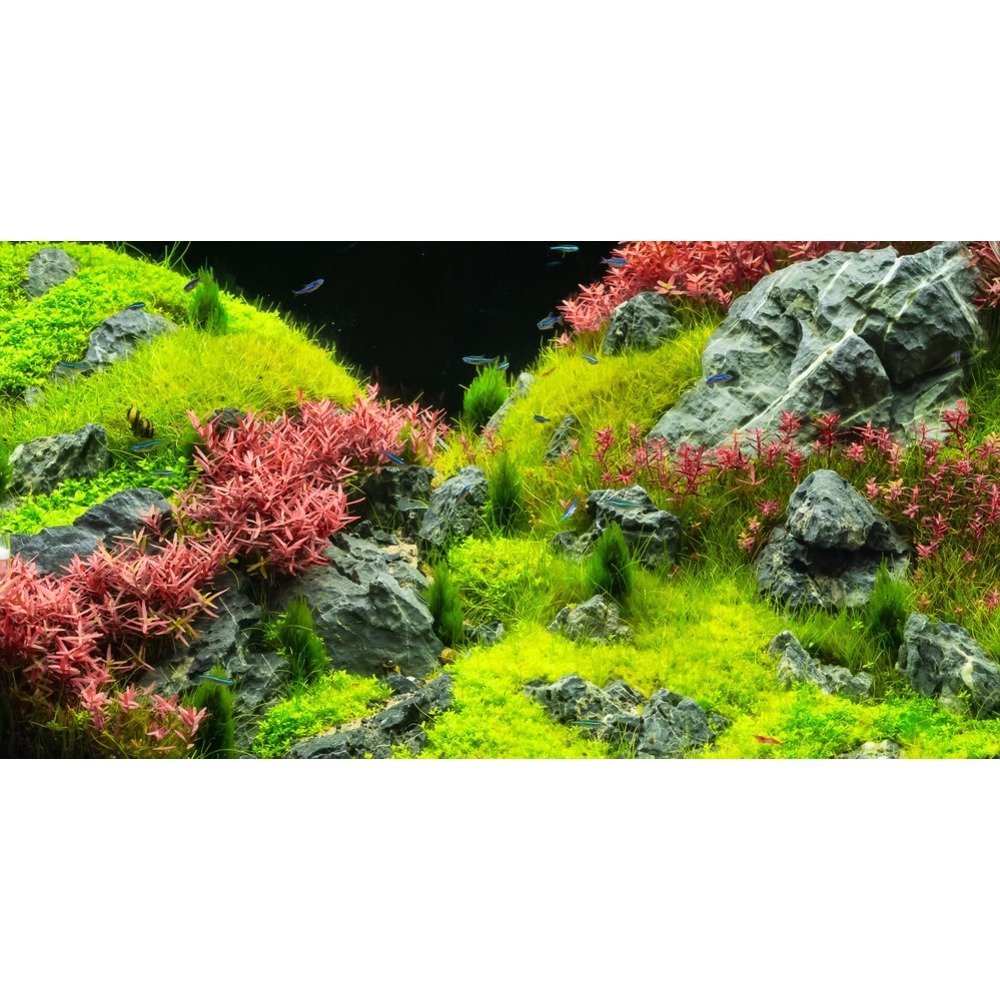 CARPET PLANTS
4
CARPET PLANTS
4
-
 CLEARENCE SALE
1
CLEARENCE SALE
1
-
 DRIFTWOODS
5
DRIFTWOODS
5
-
 EPIPHYTES
5
EPIPHYTES
5
-
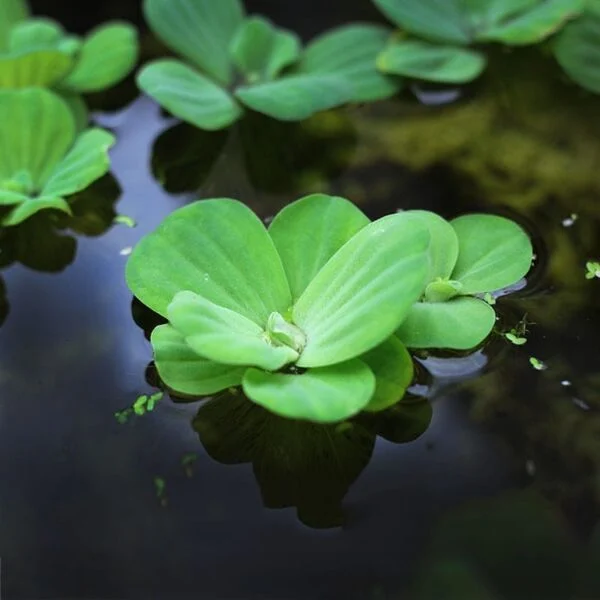 FLOATING PLANTS
1
FLOATING PLANTS
1
-
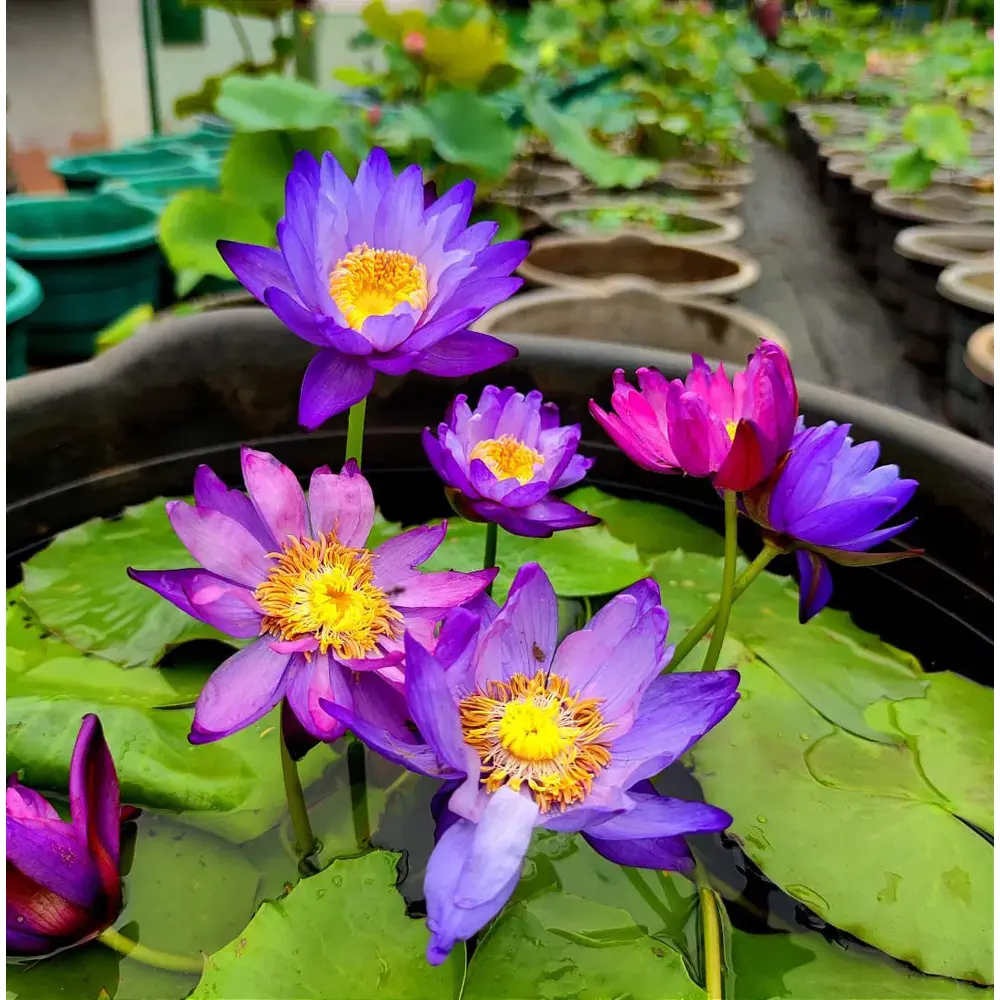 LILY
4
LILY
4
-
 LIVE FISHES
178
LIVE FISHES
178
-
 LIVE PLANTS
54
LIVE PLANTS
54
-
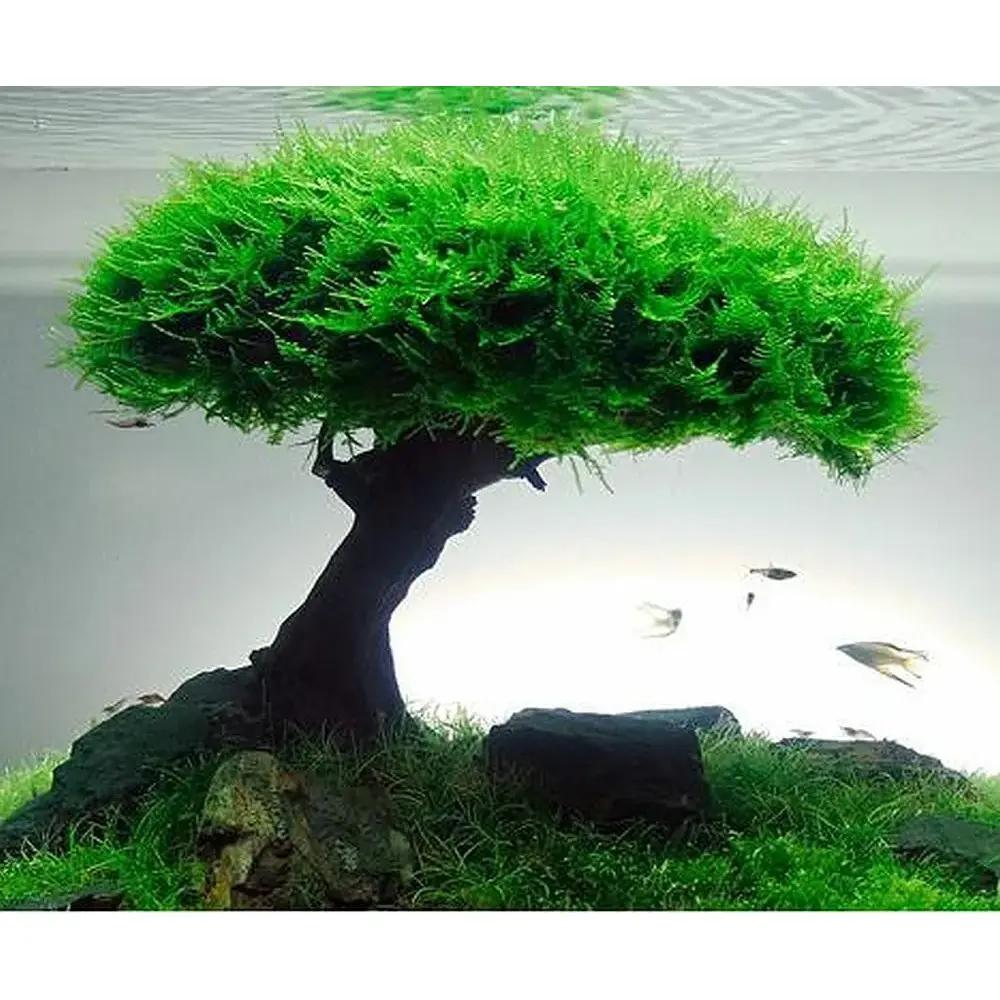 MOSS
6
MOSS
6
-
 PLANTED AQUARIUM
41
PLANTED AQUARIUM
41
-
 POT PLANTS
26
POT PLANTS
26
-
 STARTERS
5
STARTERS
5
-
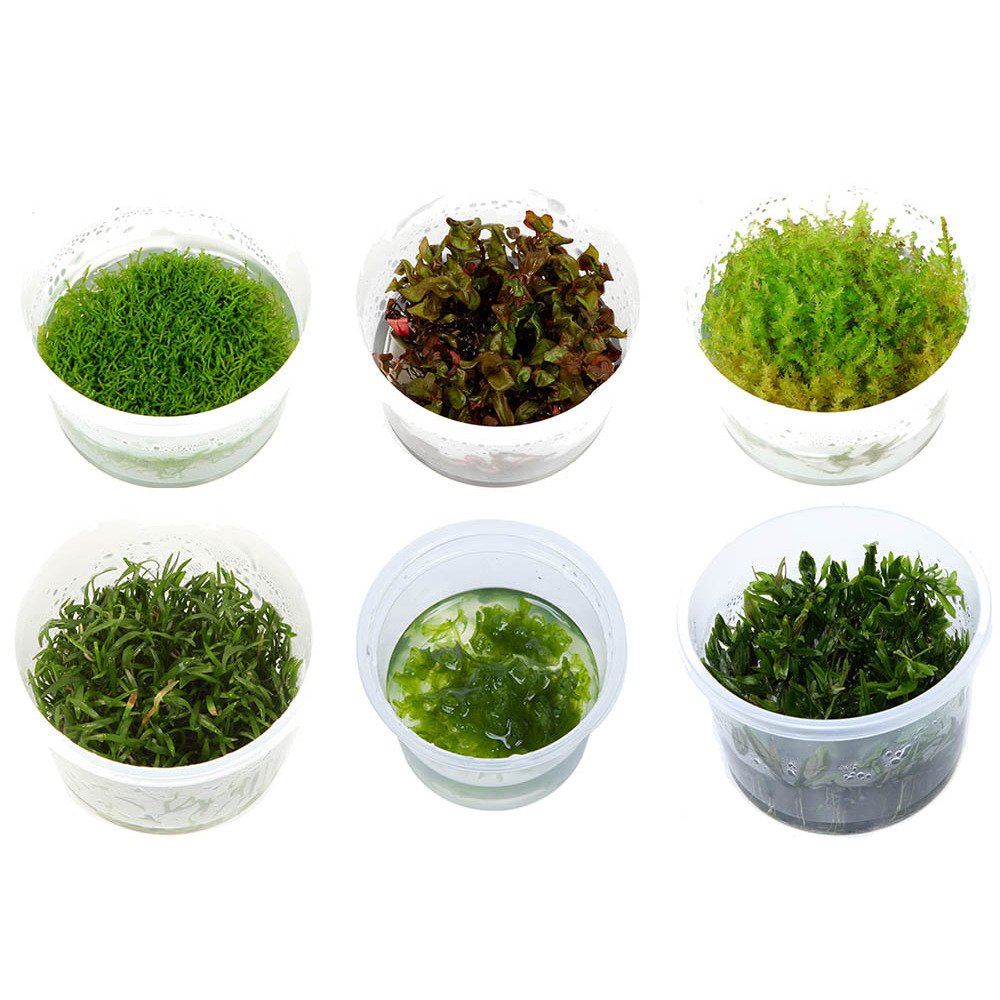 TISSUE CULTURE
11
TISSUE CULTURE
11
-
 TOYS/ DECORS
71
TOYS/ DECORS
71

